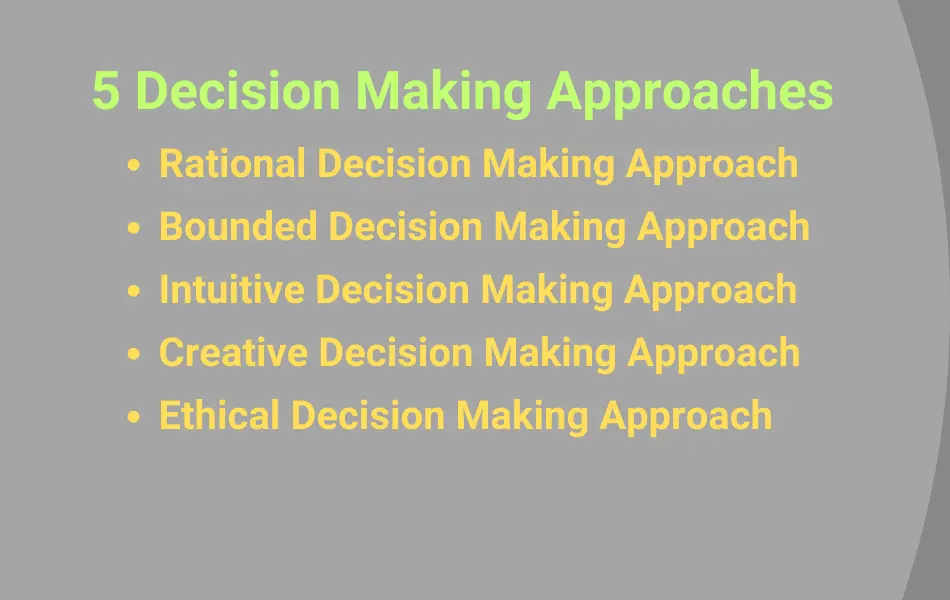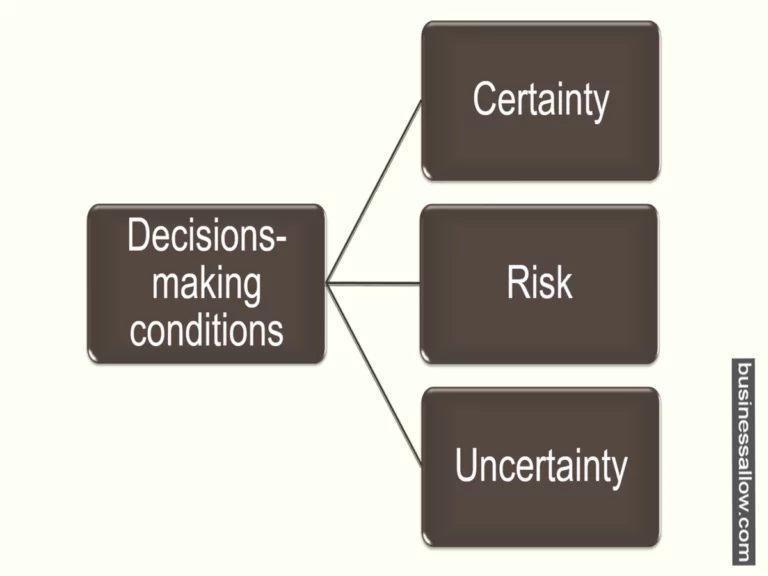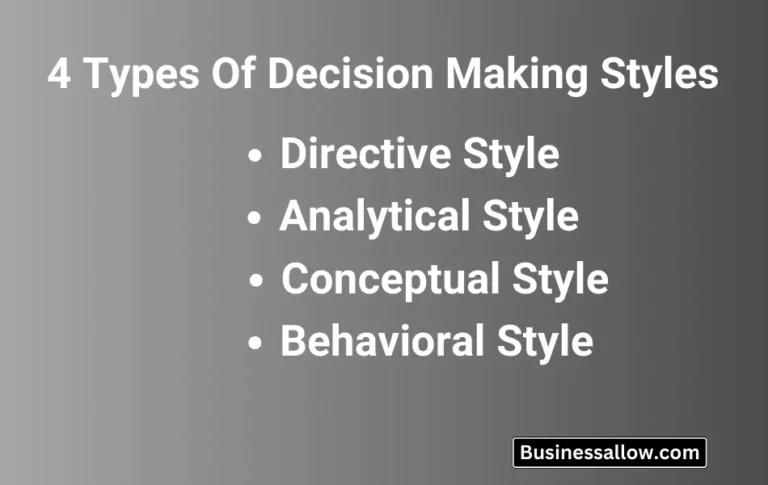5 Decision Making Approaches – Full Guide 2024

What Are Decision Making Approaches ?
Decision making approaches mean the different ways people and groups decide things or solve problems. It’s like having a bunch of methods to pick from when you need to make a choice. These methods help you figure out what to do in different situations, whether on your own, working with others, or part of an organization.
In this discussion, we’ll explore 5 different decision making approaches in management. Think of it as a guide to understanding the many ways you can make better choices in life.
Content Outline
5 Types of Decision Making Approaches – Explained
1. Rational Decision Making Approach
Rational decision making is a step-by-step method that assists in making thoughtful, informed, and logic-based choices. It involves clearly identifying a decision to be made, gathering essential information, identifying possible solutions, evaluating the alternatives, and making a final decision.
At its most basic level, the rational approach assumes that individuals have complete information and can process that information objectively and logically. This approach is based on the belief that the decision maker has the time, resources, cognitive ability, and objective mindset to find the best possible option and achieve optimal results.
Steps in Rational Decision Making Approaches:
- Identify the Problem: The first step in rational decision making is acknowledging a problem that needs to be solved.
- Establish Criteria: Defining what outcomes or attributes are essential in solving the problem. The criteria must reflect what you value most.
- Weigh Decision Criteria: As not all criteria will hold the same importance, weighing them based on their relevance to the decision at hand is necessary.
- Generate Alternatives: Develop a list of possible solutions or courses of action. This step involves creativity and the ability to foresee potential solutions.
- Evaluate the Alternatives: Review the pros and cons of each alternative using the established criteria. This stage involves predicting the outcome of each choice.
- Choose the Best Alternative: After careful evaluation, the best alternative is chosen—the one that generates the most advantages and the fewest serious disadvantages.
- Implement the Decision: Carry out the chosen alternative. The decision is transformed into a specific set of tasks.
- Evaluate the Effectiveness of the Decision: The final step involves an appraisal of whether or not the chosen solution had the expected outcome or if the problem was correctly identified in the first step. The effectiveness of the decision is evaluated, and adjustments are made if required.
Advantages:
- It provides a step-by-step guide for problem-solving, leading to a logical and optimal decision.
- It encourages objectivity and structure in decision making.
- Rational decision making focuses on facts and data, reducing the impact of personal biases and emotions.
Disadvantages:
- The assumption that we always have complete and perfect information is often unrealistic. Decision makers must frequently make decisions under uncertainty, ambiguity, and incomplete information.
- The process may be time-consuming, particularly for complex decisions.
- The approach can be unsuitable for emotional or value-based decisions, often requiring a more humanistic or intuitive process.
2. Bounded Rationality Decision Making Approach
The bounded rationality approach is like saying we can’t always make super-intelligent decisions because we have limits. This idea, first discussed by Herbert Simon, tells us that when we make choices, we do the best we can with the information we have, the time we have, and our brain’s abilities. It means we can only sometimes make the perfect choice in real-life situations, so we pick one that’s pretty good, even if it’s not the best. We call this ‘satisficing’ because we’re going for decisions that are good enough, not necessarily the very best ones.
- Advantages:
- Realistic and Flexible: It acknowledges the practical limitations of decision-making and offers a more realistic perspective on human behavior.
- Promotes Promptness: It can result in quicker decisions. Instead of waiting to gather all possible information— which could lead to decision paralysis— individuals make the best decision possible with the available information.
- Disadvantages:
- Not Optimally Efficient: Since the decisions made under this approach are satisfactory rather than optimal, there is a risk of missing out on the absolute best solution or decision.
- Subjectivity: The decisions depend on a person’s interpretation of what is satisfactory, inviting subjectivity into the process.
- Incomplete Consideration: Important factors may need to be noticed due to the limitations of time or cognitive resources.
3. Intuitive Decision Making
Intuitive decision making means making choices based on feelings and past experiences rather than overthinking things. It’s like using your gut feeling or ‘sixth sense’ to decide what to do, especially when complicated or not precise.
A big part of intuitive decision making is the “recognition primed decision“ model. This model says that experts often decide things by seeing similarities between what they’re facing now and what they’ve seen before. When they see these similarities, they automatically come up with possible choices or actions, which makes it feel intuitive. But it doesn’t mean they don’t think things through. They still imagine what might happen with each choice to make sure it makes sense for the situation.
- Advantages of intuitive Decision Making:
- Fast Decision-Making: This approach is much quicker than conventional decision-making methods that require comprehensive information and analysis. This speed is especially beneficial in high-stakes or time-sensitive situations where decisions must be made quickly.
- Adaptable to Complex Situations: Intuitive decision making can navigate complexities and uncertainties that analytical methods may struggle with, handling complexities that are difficult to quantify or verbalize.
- Relies on Experience: Those with a wealth of experience in a particular area are likely to make more accurate intuitive decisions, as their ‘gut feelings’ are attuned to the nuances of their field.
- Disadvantages of intuitive Decision-Making:
- Potential for Bias: Intuitive decisions can be influenced by personal biases, emotions, or subconscious factors, leading to potentially subjective or inaccurate choices.
- Difficulty in Justification: Because intuitive decisions are often made quickly and with systematic analysis, it can be easier to justify such decisions.
- Inconsistency: Intuitive decisions can vary from person to person or from moment to moment, leading to inconsistencies.
- Lack of Development without Experience: For individuals without extensive experience in a particular field, intuitive decision-making can be hit-or-miss, potentially leading to poor decisions.
Balancing intuition with more rational and systematic methods of decision making can lead to a more holistic decision making strategy.
4. Creative Decision Making
Creative decision making is a process that helps individuals and groups explore different, innovative options and make decisions that are effective and unique. This approach is not about choosing from existing options but generating new and out-of-the-box alternatives. Creative decision making involves lateral or divergent thinking, moving away from traditional linear or logical approaches. The process encourages brainstorming, challenging assumptions, and looking at the problem from various perspectives.
- Advantages of Creative Decision Making Approaches:
- Innovation: The creative approach fosters innovation by encouraging thinking beyond the established paradigms. It helps in finding unique solutions to problems.
- Encourages Exploration: This process promotes exploration and challenges existing norms and beliefs, leading to the evolution of new ideas.
- Adaptability: Creative decision-making is particularly useful in complex and rapidly evolving environments where traditional strategies might not work.
- Competitive Advantage: Unique and innovative solutions can provide a significant competitive advantage in the business landscape.
- Disadvantages of Creative Decision Making Approaches:
- Time-Consuming: Creative decision making can be a time-consuming process. Brainstorming and vetting creative solutions often require a significant amount of time.
- Risk of Failure: Innovative ideas come with a chance of failure. They may only sometimes be practically feasible or economically viable.
- Resistance to Change: Creative solutions often require change, and there can be resistance from employees or stakeholders who prefer established methods or fear the uncertain outcomes of a creative approach.
- Requires Open Mindset: Only some people are comfortable with creative thinking. Some people prefer structured and standard methods of decision making.
5. Ethical Decision Making Approach
Ethical decision making is like picking the right thing based on what’s fair and honest. When we make moral choices, we’re ensuring we don’t do anything wrong. It’s essential to look at all the options and choose the one that follows the rules and treats everyone well.
This approach uses values and principles like honesty, fairness, and respect to help us decide what’s right. It’s like having a guide that tells us to do the right thing, even when it’s hard.
- Benefits of Ethical Decision Making Approaches:
- Trust and Being Trusted: People trust us more when we make ethical choices. It’s like building a good reputation, and it shows that we’re reliable and honest.
- Success for a Long Time: Making the right choices might not always give us quick rewards, but it helps us succeed and last in the long run.
- Avoiding Problems: Ethical decisions can keep us out of trouble. They stop us from doing things that could get us in legal trouble or damage our reputation.
- Happiness at Work: When we make decisions that feel right, it makes us happy at work. It also makes the workplace a better and happier place.
- Helping Society: Ethical choices don’t just benefit us; they make society better, too. They can make things fairer and help protect the environment.
Related: Types of decision making
Conclusion
So, there you have it—five different decision making approaches in management. Each method offers its own way of tackling choices, whether it’s through rational analysis, practical satisficing, intuitive gut feelings, creative thinking, or ethical principles. Remember, no single approach is always the best; the key is knowing when to use each. Making decisions is like having a toolbox, and these approaches are the tools to help you make the right call in different situations. Happy decision making!






